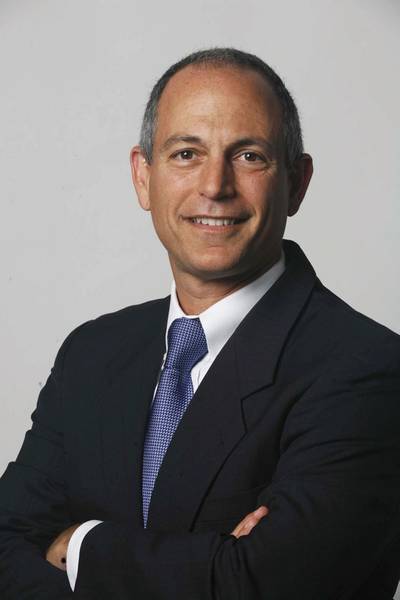Insights: Steven Candito, President & CEO, NRC
This month’s featured INSIGHTS executive is Steven A. Candito, President and CEO of the National Response Corporation (NRC). He has extensive experience with OPA 90 compliance issues with particular focus on vessel owner and insurance matters. Candito was previously an attorney with Haight Gardner Poor & Havens, specializing in maritime litigation and environmental law. He also served as a marine engineer aboard Exxon USA’s domestic tanker fleet from 1980 to 1985. Candito is a graduate of Hofstra University School of Law and the United States Merchant Marine Academy. He is a past President of the Spill Control Association of America. Listen in as he aptly describes the business model of the global ‘for profit’ response provider.
Flesh out for us the ‘for-profit’ business model of the OSRO NRC.
From a cost comparison perspective, as with any for-profit business, you must focus on making good business decisions, operating efficiently and continuous improvement. NRC has structured its business and operations to meet the needs of its customers while keeping its costs low and offering fair prices. A good example of this fact relates back to the genesis of NRC. At that time, MSRC was building 20 new response vessels at a cost of about $16 million each. NRC recognized that vessels with very similar hull characteristics already existed and many were out of service because of the market conditions in the early 1990s. NRC was able to buy existing supply vessels very cost effectively and convert them into Oil Spill Response Vessels (OSRVs) to meet the OPA 90 requirements at a cost of about $1 million each. With a significantly lower capital structure, we were able to provide our OPA 90 compliance service at much lower fees, even though our fees included a profit component. Those same innovative ideas continue today with our new compliance service in Alaska where we are making use of a combination of dedicated and non-dedicated resources to meet the regulations cost effectively.
Give us a sense of the size of your company – employees, assets, vessels, and geographical reach.
NRC’s 3,000 clients include foreign and domestic oil majors and independents as well as manufacturers, utilities, architectural and engineering firms, and, of course, the transportation sector (shipping, rail, trucking, etc.). We also provide a variety of services to federal, state and local government agencies. Domestically, NRC holds the highest USCG OSRO classifications for all operating environments in all U.S. Captain-of-the-Port (COTP) Zones (except Alaska). With over 1,000 full time employees, NRC maintains personnel and response equipment throughout the U.S., Puerto Rico, and the U.S. Virgin Islands. NRC response equipment and resources are strategically positioned within the COTP zones in order to provide regulatory response and other environmental and industrial services to our clients. NRC resources include a Marine Resource Network, which supplements our owned fleet of 20 offshore OSRVs and Oil Spill Response Barges (OSRBs); as well as specialized response equipment such as shallow water portable barges, boom, skimming systems, response trailers and mobile communication centers. In addition to our owned equipment and full time personnel, NRC maintains an expansive Independent Contractor Network, which enables us to rapidly cascade response equipment and up to another 5,000 trained personnel to an emergency. Internationally, we operate a number of major response facilities located in the Mediterranean, Caspian Sea, Black Sea, Middle East and Far East regions. On a worldwide basis, NRC is supporting oil majors and independents by providing Tier I and Tier II response solutions as well as specialized support services to our worldwide clients. We also provide environmental and industrial services to the North Sea market.
Any business model solely dependent on spill revenue is likely to have challenges. So, what do you rely upon for income during the times that no events are occurring?
NRC is a fully diversified environmental services company. Emergency response to oil spills is just one aspect of our business. However, all of our business lines – standby services (including response) and environmental and industrial services – are complementary businesses. Our OPA 90 standby compliance business generates retainer revenue that supports the purchase, maintenance, and prepositioning of equipment as well as the training and prepositioning personnel, even if we are never called to respond. If this business were our only service, it would not be attractive to our investors because the potential revenue from spills is too unpredictable. Thus, we leverage our equipment, personnel and client relationships to generate revenue and profits from our other day-to-day environmental and industrial service lines.
Are most of your fleet assets non-dedicated vessels on retainer? What if one is in the middle of a cargo run when you need it most?
First, most of our owned vessels are dedicated to spill response. We have several owned non-dedicated vessels that routinely work in local activities such as bunkering, survey, or diving support. In these situations, the vessels must remain in a specific geographic area and their charters allow for their immediate release so that we can meet the OPA 90 time frames, if we need the vessel for a spill response. We also identify back-up resources from our Marine Resource Network if there is a chance that the owned resource cannot meet the time frame. This combination of dedicated and non-dedicated resources, along with some redundancy, enables us to keep sufficient resources in a standby readiness state leaving other assets available for project work. One of our programs has been to equip work or supply vessels with some essential response equipment. In a spill, these work vessels will often be the first on scene and have the capacity to immediately deploy boom or begin some skimming operations until back-up or more fully equipped dedicated response vessels arrive on scene.
You’ve asserted that routinely used assets and personnel operating equipment are more proficient when they use it frequently. Give us some examples.
It may be helpful to use a college sports analogy to better explain this point. When evaluating a team, we often look at the number of “returning” players that have had the experience of playing in real games from prior seasons. Now even though most teams practice a similar amount during the course of a season, we often give the edge to the team with more returning players because they have been “battle tested.” We certainly still need to train and inexperienced teams can be good, but if I have a choice I am going with the team that has the most returning players. So translating that analogy to our business means personnel that are experienced in operating equipment almost daily in routine situations will operate equipment more effectively and safely during emergencies. Real working experience, along with strong training and exercise and safety programs, encourages the vitality of our operations and better management practices. Our diverse service offerings give us greater control over our project work and more oversight to vet our personnel, subcontractors, and business functions in non-emergency situations. It also enhances the services that we can offer to our clients.
With the new Salvage & Marine Firefighting rules, have lines between salvage, response and remediation blurred some? If so, is that a good thing?
The lines are still fairly well defined from a compliance perspective with the exception of Alaska where NRC as an OSRO and Resolve Marine Group (Resolve) as a Salvage & Marine Firefighting provider are jointly providing OSRO compliance services via our 1Call Alaska service. I am biased since we developed the service with Resolve, but I certainly think it is a good thing. On the OPA 90 compliance side, our 1Call Alaska service is helping to drive down prices and improve service. On the response side, we clearly will provide a more timely and coordinated salvage and spill cleanup response than has historically been available along the Aleutian island chain in Western Alaska. With that goal in mind, partnering with Resolve was clearly the most cost effective way to provide the needed and improved compliance service in Alaska. The response resources in this area have, until recently, been somewhat limited. Also, new add-ons to OPA 90 now require shipowners to have salvage and firefighting agreements similar to our traditional OSRO compliance agreements. NRC and Resolve have many shipowner clients in common and marine salvage response often goes hand-in-hand with oil spill response.
You have stated, “There is no doubt that NRC’s presence in the market has kept not-for-profit fees in check.” Give us a garden-variety example of that metric in actual practice.
Two good examples involve regulatory compliance services in the State of Washington and in Alaska. The non-profit cooperatives operating in both of these areas left few compliance options for the vessel operators creating costly fees for the shipping community. In Washington, the Department of Ecology (WDOE) requires tank and non-tank vessels to have additional response capabilities beyond those required by the Federal OPA 90 requirements. In 2014, NRC became a fully approved Washington State Contingency Plan holder, which gave our vessel clients the option to enroll under NRC’s more economical umbrella plan for compliance with WDOE requirements. Prior to NRC receiving its stand-alone approval, vessels operators had one option for this requirement and that was to sign-up with the local not-for-profit cooperative. As a result of NRC entering the market in Washington and with our Alaska initiative to expand commercial services with 1Call Alaska, the fees for compliance services in both of these regions have become more competitive. As a result, we understand that the local not-for-profit cooperatives are also purchasing or contracting for additional equipment and are trying to become more user friendly by revising their service agreements to be in compliance with the International Group of P&I Clubs’ guidelines. These improvements likely would not have happened without NRC’s entry into the market.
NRC provides not only OPA 90 OSRO compliance services, but also many other environmental services around the world. Some describe this diversification as ‘lack of focus,’ but you call it critical to your success. Tell us why.
NRC has been strategic in diversifying into businesses that support and enhance our core service offerings. But it is not just about broadening our services, it is also about innovation and adding more specialized and unique capabilities to our business portfolio, such as our acquisition of SRS, a company that specializes in the routine transfer to highly flammable or caustic products as well as response to emergencies. As a result, our many clients have enjoyed the benefits of our innovation and cost effectiveness via great service and reasonable costs. Again, it’s about adapting to the market, maintaining cost effectiveness, while increasing performance and work quality. These are the benefits we deliver to our clients.
Describe the most important lessons learned during and after the Deepwater Macondo incident?
NRC was one of the first contracted OSROs to be on scene at the rig site and maintained operations well beyond the capping of the Macondo wellhead. We were involved in most aspects of the 2010 response with crews spanning four GOM States. NRC deployed over 150,000 feet of offshore boom, 112 skimming systems, 14 dedicated response vessels and barges along with another 400 third party vessels sourced through our Marine Resource Network. NRC was also a major contributor to the aerial dispersant operations that were critical to the response effort; and we managed 48 decon sites through the response area. First, we learned that dedicated resources alone would never be sufficient for a large event. Second, no matter how significant the event, an OSRO should not move all its dedicated resources from other regions to the current event. Some resources should be left in reserve to protect other regions from a subsequent spill. The Macondo well release was a historic event for all involved in the response. It was a major undertaking to deploy the massive amounts of response equipment spanning four states along the GOM. Our ability to source and activate 400 substantial work vessels for the response effort was confirmation that our response business model, which includes both dedicated and non-dedicated resources and contractor networks, is the better option. While a tremendous amount of equipment was sent to the GOM, NRC still maintained sufficient equipment stockpiles in all other operating areas in the event of an unrelated spill during that time. Equipment readiness in areas removed from the GOM was a particular concern to many of our clients and we were able to satisfy that need, where not-for-profits that relied only on their own dedicated resources were challenged by this issue.
You talk about innovation from the private sector – tell us about where NRC is involved in spill research and product / service development.
Our strength is the creative and entrepreneurial approach we take to our business. Whether it is utilizing non-dedicated response vessels for project work, such as providing on-water recovery services to a major private space exploration company, to offering insurance liability solutions for our vessel clients during offshore oil spill incidents, we take a fresh look at the issues at hand and offer creative, cost-effective solutions. For example, in 2012 the OPA 90 regulations were expanded to require tank (and now non-tank) vessels to have aerial dispersant capabilities. This new requirement as well as the dispersant litigation that arose from the Macondo spill led to concerns over the Responsible Party’s liability when chemical dispersants are used in a spill. At the time, our competitor took a hardline approach that assumed no risk for such dispersant uses pushing all liability and risk to their clients via a short notice contract change. NRC’s approach was to work closely with our clients and with their Protection & Indemnity Clubs (insurers) to provide better risk allocation to the vessel owner. Further, we implemented this enhanced contract option during our next contract renewal period, not on short notice. This solution meant increasing our own insurance coverage and agreeing to share risk with our client. NRC has also looked to research and product development to improve our operations. Finding response solutions in the heat of a response can lead to innovation. This was the case during the 2010 Macondo spill when NRC made modifications to a skimming system in order to more efficiently collect floating tar balls. This new system (Automatic Tilting Oil Skimmer) was later improved and patented by NRC. More recently NRC was one of three major OSROs approached by Booz Allen Hamilton and SEA Consulting Group to voluntarily provide survey information needed by the Bureau of Safety and Environmental Enforcement (BSEE) Oil Spill Response Division (OSRD). OSRD is updating its Oil Spill Response Plan (OSRP) regulations to reduce and mitigate risks associated with Outer Continental Shelf oil spills. The purpose of this project is to characterize regional oil spill response equipment, technology, and strategies for BSEE’s OSRD regulation developers. At present, the study is still in process and information is still being compiled for submission.
(As published in the March 2015 edition of Marine News - http://magazines.marinelink.com/Magazines/MaritimeNews)














